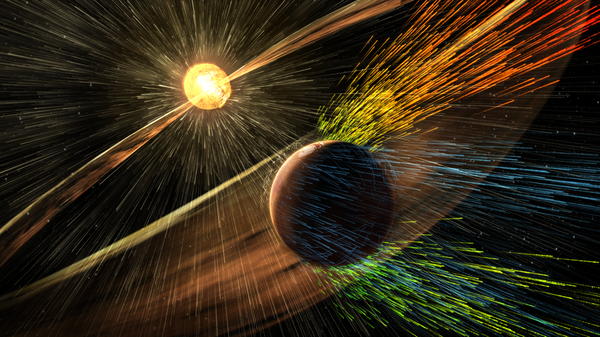This article was published in Scientific American’s former blog network and reflects the views of the author, not necessarily those of Scientific American
Exoplanetary science and astrobiology spend quite a lot of time worrying about how rocky planets evolve. In part this is in order to better understand how to interpret data on very basic quantities like planetary mass and measured radii. It's also in order to interpret measurements about atmospheric compositions that are only just starting to become feasible to make. But perhaps more than anything else we'd like to know how a world might support environments that in turn could support life akin to terrestrial life.
One critical factor is the extent to which a planet can sustain a water-rich surface environment, along with an associated hydrological cycle. But while making rocky planets with plenty of water may not be tricky or unusual, having them hold onto that water may be tougher.
A key factor is to do with atmospheric loss. If water molecules get lofted high enough in the atmosphere of a planet like the Earth (for example) they can be dissociated into hydrogen and oxygen by ultraviolet light. That hydrogen, being light, is most vulnerable to being lost forever to space. Consequently the original water molecule cannot reform, ever, and the planet dries out a molecule at a time. Stellar activity, in the form of ultraviolet light, protons in a solar wind, or the fearsome stormfront of a coronal mass ejection, can crank atmospheric loss - especially of hydrogen - up to a severe level.
On supporting science journalism
If you're enjoying this article, consider supporting our award-winning journalism by subscribing. By purchasing a subscription you are helping to ensure the future of impactful stories about the discoveries and ideas shaping our world today.
It's for this reason that astronomers and exoplanetary scientists have been trying to better understand how the lowest mass stars (M-dwarfs) behave. These stars are the most numerous in our galaxy, they have planets, and the nominal habitable orbital range for those planets is close in to these very low luminosity objects. But M-dwarfs are notoriously ill-tempered when it comes to activity. They are, to be blunt, nasty little buggers. As a result the suspicion is that it may be very challenging for rocky, Earth-analog, worlds to maintain their water budget over time.
Something that could help is the presence of a strong planetary magnetic field. It might not solve everything, but it seems like it could mitigate some of the effects of charged particle radiation from a stellar host by reducing the rate of atmospheric loss.
But how often do planets manage to sustain the necessary geodynamo (internal circulation of conductive material) for some kind of global magnetic field? The answer is that we don't really know. But a recent study by Stixrude, Scipioni, and Desjarlais published in Nature lends support to a mechanism that could have operated on a very young Earth, and by extension on other young rocky planets, and perhaps larger super-Earth worlds.
In a nutshell, on Earth there is evidence of a global magnetic field going back some 3.4 billion years. But before that time it's not obvious how the iron-rich, conductive, and still very hot core material could have produced the necessary convective circulation patterns of a geodynamo. But now it seems that a molten silicate layer around the core could have been conductive enough (a 100 times more conductive than in more modest conditions) and have undergone the necessary dynamics of cooling and convection to generate magnetic fields.
This silicate dynamo in the basal magma ocean of a young Earth could 'fill the gap' in that first billion years or so until the iron outer core could take over. Thereby helping the planet retain its atmosphere and water.
By extension, a similar silicate dynamo could exist in other young rocky planets, including those suffering the indignities of orbiting M-dwarf stars. Furthermore, larger super-Earth worlds might have more substantial internal magma oceans and therefore be even better at producing a silicate dynamo and a magnetic field.
A complication is that the form of the field of a silicate dynamo might be different, due to its generation in a shallower zone of circulating material. Perhaps a dipole-like (north-south) field isn't the result. But it's possible that paleomagnetic studies of the Earth could reveal some clues. In either case, it seems that it might be very premature to discount planets from being targets in the quest to find signs of life elsewhere based on assumptions about their pasts. There may be more than one way to pop up a magnetic shield.
